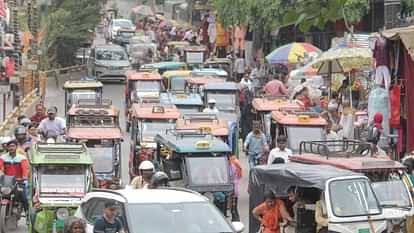Discover the various methods that the city of Varanasi is employing to alleviate the varanasi traffic congestion that exists between Godowlia and Dashashwamedh. These methods include the implementation of no-vending zones, geo-tagging, and model street food hubs. The goal of these measures is to make the journey more enjoyable.
introduction
In order to effectively manage the varanasi traffic congestion that it encounters, the city of Varanasi, which is both one of the oldest and most culturally engaged cities in India, has a persistent challenge. There is a significant amount of varanasi traffic congestion in the area between Godowlia and Dashashwamedh, which is a region that is frequented by a big number of tourists as well as residents of the neighborhood.

As a consequence of the recent actions made by the Varanasi Municipal Corporation, there is potential for a significant change to occur in the manner in which traffic is controlled in the city of Varanasi. These measures include the establishment of model food centers on the street as well as the implementation of zones that do not allow vending machines.
In this in-depth study, we investigate the creative ways that are being utilized to alleviate the problems caused by varanasi traffic and to improve the urban experience for both locals and tourists for the purpose of making the city a better place to live.
Because of the difficulties that are currently being experienced by the varanasi traffic
For a considerable amount of time, the problem of varanasi traffic has been a source of concern. Consider the following, which are some of the most pressing concerns:
Roads That Are Both Short and Narrow
Tiny streets, which are usually insufficient to accommodate the volume of varanasi traffic that exists now, are a defining characteristic of the layout of the historic city.
- Increasing the size of the tourist population that comes to visit
As a result of the fact that Varanasi is visited by millions of tourists each year, the streets of the city are frequently crowded. This is especially true in significant neighborhoods like Godowlia and Dashashwamedh.
Third, street vendors who are not subject to any form of regulation
Despite the fact that street vendors are a vital part of the culture of the city, they take up valuable road space, which not only makes varanasi traffic problems worse but also makes the situation much more difficult.
- Positions Available for Parking There are
Automobiles are compelled to park on the streets because there are not enough parking spots available, which causes a disruption in the flow of traffic. - Public transit service that is ineffective and inefficient
There is a lack of organized options for public transit, which is one of the reasons that contributes to the high reliance on private vehicles.
Varanasi will not have any vending machines as a result of the project that is being implemented.
In an effort to address the concerns that have been raised, the Varanasi Municipal Corporation has just announced that they will be implementing a significant move that will designate the stretch of road that runs between Godowlia and Dashashwamedh as a zone that does not allow vending machines.

Information that is of critical significance with regard to the initiative
The provision that “No Street Vendors in Critical Areas” is made abundantly plain.
As a result of this change, it will no longer be acceptable for merchants to set up stalls on the roads. This change will serve to guarantee that walkers and motorists have access to paths that are not completely blocked.
The method of geotagging that is used by vendors
The vendors who are located in other parts of the city will be subjected to geo-tagging, which will result in the production of a digital map of their places. This will be done for the aim of improving regulation and management.
Serving as an Example for Food Dispensaries on the Street
The implementation of flyovers will lead to the transformation of certain locations into structured street food centers. These centers will provide food enthusiasts a variety of options that are not only hygienic but also easily accessible.
- “Enhanced Parking Rules” (in this particular instance)
A prohibition on parking will be implemented on this stretch of road, and there are plans to create alternative parking zones in the areas that are immediately adjacent to it.
Geographical tagging is a modern approach to the issue of traffic regulation that has been brought up recently.
In the direction of the management of smart cities, the use of geo-tagging is a revolutionary step. The following are some of the ways in which Varanasi traffic will benefit:
- “Identification of Potential Vendors”
Identification cards, certifications, and barcodes will be distributed to each and every street vendor in order to guarantee that they are in compliance with the restrictions that have been established by the city.

Transparency and monitoring are the second point. Through the monitoring of the operations of vendors in real time, it is possible to prevent unlawful encroachments on highways.
- Decisions that are driven by the examination of data
The geo-tagged data will be of great assistance in all aspects of urban infrastructure expansion planning, including the development of future vending zones and other urban infrastructure expansions. - An Increased Measure of Accountability As a result of suppliers being held accountable for operating within their designated parameters, there will be fewer arguments and less interruption. This is because there will be fewer disagreements.
The establishment of model street food hubs is a solution that is beneficial to both sides.
The allure of Varanasi is intrinsically related to the street food that is available throughout the city. With the execution of the concept to construct model street food hubs under flyovers, the city will be able to preserve its culinary culture while simultaneously resolving difficulties about traffic. This will be accomplished through the implementation of the model.
The following are some of the traits that are shared by the model street food hubs:
- Provisions for cleaning and sanitation facilities
Vendors will conduct their business in spaces that have been appropriately cleaned, well-organized, and provided with waste disposal systems that are suitable for the situation. - “Roads That Are Friendly to Tourists”
Not only will these hubs be purposefully constructed to attract tourists, but they will also be positioned in such a way that they will not disrupt the flow of Varanasi traffic. - The involvement of Independent Vendors in the Procedure
Every single street vendor who is registered will be provided with accommodations, ensuring that their means of subsistence will not be adversely affected in any way.
The aesthetic appeal has been improved.
Varanasi’s cultural and spiritual atmosphere will be in accord with the presence of contemporary infrastructure, which will increase the aesthetic appeal of these centers and bring them into harmony with the overall mood.
An Investigation of the Effects that No-Vending Zones Have on the Automobile Varanasi Traffic
It is believed that the introduction of the proposal to prohibit vending machines will result in a number of positive outcomes, including the following:

It is made easier for varanasi traffic to flow through the area.
When there are no more vendors intruding on roadways, there will be a significant reduction in the amount of traffic congestion that occurs.
Streets that are less hazardous
The presence of wide paths will be beneficial to pedestrians, which will result in a reduction in the number of accidents and injuries that occur.
- A more pleasurable experience gained from the tourism experience
The Dashashwamedh Ghat is one of the well-known sites that is able to provide guests with an experience that is free of any complications. - “Enhanced Urban Management” The establishment of a pattern for the organization of urban government has been established through the regulation of activities related to street selling.
Efforts made in association with one another with the intention of delivering sustainable solutions
Whether or whether this endeavor is successful is dependent on the degree to which the authorities, vendors, and communities collaborate effectively in order to achieve their objectives. What is essential to keep in mind is that:
Participation of Stakeholders To begin, it is essential to schedule regular meetings with local vendors and community leaders in order to ensure that there is mutual understanding and partnership. This is the most critical step.
- Offering Educative Opportunities to Vendors
As a result of their participation in seminars and training sessions, vendors are better able to appreciate the benefits that come with organized selling zones. - The implementation of rules with a stringent level of enforceability
In order to ensure that parking and no-vending restrictions are strictly adhered to, municipal authorities are expected to ensure that these regulations are followed. - Various Approaches to Acquiring Customer Feedback
When it comes to refining the endeavor, receiving feedback from neighborhood residents and tourists on a regular basis will be of tremendous benefit.
Expanding the Initiative’s Scope is One of the Proposed Future Plans For the Initiative
The Varanasi Municipal Corporation has the intention of implementing this plan across the entirety of the city to make it more comprehensive. These are the plans that are currently being developed and are as follows:
The Establishment of Modern Parking Equipment and Facilities
The construction of multi-level parking garages is under underway in an effort to find a solution to the issues surrounding parking.

The second characteristic of intelligent traffic management systems is the incorporation of surveillance cameras and traffic lights that are powered by artificial intelligence for the goal of establishing efficient traffic control.
An Increase in the Number of Machines That Accept Payment
The construction of new vending zones that are outfitted with more advanced facilities will take place in areas that are expected to have a lower population density.
Improvements to the System Operating for Public Transportation
At the moment, there are efforts being made to enhance the alternatives to public transportation and to create buses that are friendlier to the environment.
The Results and the Analysis
As a result of the city of Varanasi’s attempts to tackle traffic congestion through the introduction of modern techniques such as geo-tagging and no-vending zones, the city has taken a significant step toward a contemporary urban environment. This step is a significant step toward a contemporary urban environment. Not only do these efforts help to ease the pressing varanasi traffic problems that the city is experiencing, but they also pave the way for sustainable development, which contributes to the preservation of the cultural and spiritual heart of Varanasi.
The city of Varanasi acts as a model for other heritage cities that are suffering with issues that are analogous to its own. This is because the city has successfully balanced the requirements of residents, tourists, and sellers. As these approaches become more widely used, the city can predict that the varanasi traffic will become less choppy, that improvements will be made to public places, and that everyone will have an experience that is more fulfilling.







